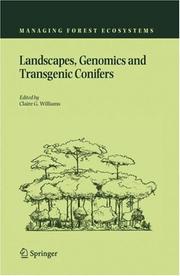| Listing 1 - 8 of 8 |
Sort by
|
Book
ISBN: 1839697776 1839697768 Year: 2022 Publisher: London : IntechOpen,
Abstract | Keywords | Export | Availability | Bookmark
 Loading...
Loading...Choose an application
- Reference Manager
- EndNote
- RefWorks (Direct export to RefWorks)
Conifers. --- Coniferae --- Coniferales --- Softwood trees --- Softwoods (Trees) --- Gymnosperms --- Evergreens
Book
ISBN: 1789848016 1789848008 1838817417 Year: 2018 Publisher: IntechOpen
Abstract | Keywords | Export | Availability | Bookmark
 Loading...
Loading...Choose an application
- Reference Manager
- EndNote
- RefWorks (Direct export to RefWorks)
The conifer tree can lead to a wide variety of products and services. Overall, the evaluation, management and planning of the multiplicity of these forest systems requires effective and specific methods and tools in a sustainable frame of the systems and of their products and services. This book reflects the current research on conifer stands and forests. The authors, specialists in different areas, addressed several issues in forest science, focusing on the species' characteristics, silviculture and climate change; growth analysis; reconstruction of stand dynamics of mixed stands; establishment, regeneration and succession; litter-fall, nutrient cycle and silviculture; distribution and zonation; and ecosystem services provided by monocultures and mixed stands.
Conifers. --- Coniferae --- Coniferales --- Softwood trees --- Softwoods (Trees) --- Gymnosperms --- Evergreens --- Life Sciences --- Forestry Science --- Environmental Sciences
Book
ISBN: 0792306163 9401056471 9401137048 Year: 1991 Publisher: Dordrecht : Kluwer Academic Publishers,
Abstract | Keywords | Export | Availability | Bookmark
 Loading...
Loading...Choose an application
- Reference Manager
- EndNote
- RefWorks (Direct export to RefWorks)
Pinales --- Zone tempérée --- Temperate zones --- Identification --- identification --- Variété --- Varieties --- Nomenclature --- nomenclature --- Arbre forestier --- forest trees --- Plante ornementale ligneuse --- Ornamental woody plants --- Conifers --- -Ornamental conifers --- Ornamental conifers --- -#WPLT:syst --- Coniferae --- Coniferales --- Softwood trees --- Softwoods (Trees) --- Gymnosperms --- Evergreens --- Conifers. --- Ornamental conifers. --- Varieties. --- identification. --- nomenclature. --- #WPLT:syst --- Conifer manuel

ISBN: 9780881929744 Year: 2009 Publisher: Portland, OR London : Timber Press,
Abstract | Keywords | Export | Availability | Bookmark
 Loading...
Loading...Choose an application
- Reference Manager
- EndNote
- RefWorks (Direct export to RefWorks)
Pinales --- Évolution --- evolution --- Taxonomie --- taxonomy --- Identification --- identification --- world --- GYM Gymnospermae --- Coniferae = Conifers --- Araucariaceae --- Cupressaceae --- Pinaceae --- Podocarpaceae --- Sciadopityaceae --- Taxaceae --- descriptions --- international --- classification --- morphology --- palaeobotany --- new combinations --- distribution maps --- 588.1 --- coniferen (lt) --- groenbeheer (lt) --- evolution. --- identification. --- Conifers --- Coniferae --- Coniferales --- Softwood trees --- Softwoods (Trees) --- Gymnosperms --- Evergreens
Book
ISBN: 0890541833 9780890541838 Year: 1997 Publisher: St. Paul : APS Press,
Abstract | Keywords | Export | Availability | Bookmark
 Loading...
Loading...Choose an application
- Reference Manager
- EndNote
- RefWorks (Direct export to RefWorks)
Conifers --- Diseases and pests. --- Pinales --- Maladie des plantes --- Plant diseases --- Symptome --- symptoms --- Contrôle de maladies --- Disease control --- 630*41 --- 582.47 --- -#KVIV:BB --- #ABIB:abos --- Coniferae --- Coniferales --- Softwood trees --- Softwoods (Trees) --- Gymnosperms --- Evergreens --- General technique of forest protection. Types of injury. Methods of damage and pest control. Vitality of trees --- Coniferae. Conifers --- Diseases and pests --- Coniferae = Conifers --- phytopathology --- 582.47 Coniferae. Conifers --- 630*41 General technique of forest protection. Types of injury. Methods of damage and pest control. Vitality of trees --- #KVIV:BB --- Conifers - Diseases and pests.
Book
ISBN: 3319468073 3319468065 Year: 2019 Publisher: Cham : Springer International Publishing : Imprint: Springer,
Abstract | Keywords | Export | Availability | Bookmark
 Loading...
Loading...Choose an application
- Reference Manager
- EndNote
- RefWorks (Direct export to RefWorks)
This Book provides the first comprehensive volume on conifers detailing their genomes, variations, and evolution. The book begins with general information about conifers such as taxonomy, geography, reproduction, life history, and social and economic importance. Then topics discussed include the full genome sequence, complex traits, phenotypic and genetic variations, landscape genomics, and forest health and conservation. This book also synthesizes the research included to provide a bigger picture and suggest an evolutionary trajectory. As a large plant family, conifers are an important part of economic botany. The group includes the pines, spruces, firs, larches, yews, junipers, cedars, cypresses, and sequoias. Of the phylum Coniferophyta, conifers typically bear cones and evergreen leaves. Recently, there has been much data available in conifer genomics with the publication of several crop and non-crop genome sequences. In addition to their economic importance, conifers are an important habitat for humans and animals, especially in developing parts of the world. The application of genomics for improving the productivity of conifer crops holds great promise to help provide resources for the most needy in the world. .
Conifers --- Coniferae --- Coniferales --- Softwood trees --- Softwoods (Trees) --- Gymnosperms --- Evergreens --- Plant anatomy. --- Plant physiology. --- Plant genetics. --- Plant breeding. --- Plant diseases. --- Plant Anatomy/Development. --- Plant Systematics/Taxonomy/Biogeography. --- Plant Physiology. --- Plant Genetics and Genomics. --- Plant Breeding/Biotechnology. --- Plant Pathology. --- Botany --- Communicable diseases in plants --- Crop diseases --- Crops --- Diseases of plants --- Microbial diseases in plants --- Pathological botany --- Pathology, Vegetable --- Phytopathology --- Plant pathology --- Plants --- Vegetable pathology --- Agricultural pests --- Crop losses --- Diseased plants --- Phytopathogenic microorganisms --- Plant pathologists --- Plant quarantine --- Agriculture --- Breeding --- Genetics --- Physiology --- Plant structure --- Structural botany --- Vegetable anatomy --- Anatomy --- Pathology --- Diseases and pests --- Diseases --- Wounds and injuries --- Structure --- Plant development. --- Plant systematics. --- Plant taxonomy. --- Plant pathology. --- Botanical classification --- Botanical systematics --- Botanical taxonomy --- Classification --- Plant biosystematics --- Plant classification --- Plant systematics --- Plant taxonomy --- Systematic botany --- Systematics (Botany) --- Taxonomy, Plant --- Plant taxonomists --- Development of plants --- Plant development --- Developmental biology --- Growth (Plants) --- Ontogeny

ISBN: 9786611338824 1402038690 1402038682 9048169860 Year: 2006 Publisher: Dordrecht : Springer Netherlands : Imprint: Springer,
Abstract | Keywords | Export | Availability | Bookmark
 Loading...
Loading...Choose an application
- Reference Manager
- EndNote
- RefWorks (Direct export to RefWorks)
What is the future of genetically modified (or transgenic) conifer plantations? The content of this edited volume Landscapes, Genomics and Transgenic Conifers addresses this question directly - and indirectly - using language drawn from policy, forest history, genomics, metabolism, pollen dispersal and gene flow, landscape ecology, evolution, economics, technology transfer and regulatory oversight. Although the book takes its title from a Nicholas School Leadership forum held November 17-19, 2004 at Duke University, its de novo contents move past the forum’s deliberations. The result is a trans-disciplinary book composed of 14 chapters written by a total of 31 authors working in North America, South America, Europe and Africa. The book is written for policy experts, life scientists, government and business leaders, biotechnology writers and activists. Few decision-makers realize the unprecedented degree to which transgenic technology is now possible for forests on a commercial scale. Only a handful of the 550 living conifer species used for commodity value and even fewer species are being developed for transgenic plantations. Transgenic field trials started within the last decade but no transgenic pine plantations exist in 2005. But emergence of transgenic forest trees is still so recent that dialogue about the pros and cons is confined to the scientific community. And dialogue must move out into the public domain. The goal of this volume is to provide content for public deliberations about the genetic composition of future forests. Its Section I is composed of provocative and opposing views on the question of transgenic conifer plantations. Sections II and III follow with research advances on relevant conifer genomics and ecology research, respectively. Section IV forecasts rates of technology adoption for different case studies. Finally, Section V compares the status of regulatory oversight of transgenic forest trees between Canada and the United States. But will the book fulfil its goal? The burden of the answer lies with its readers. Will readers act – or will transgenic forests be seen as too remote or simply too rural to bother with the angst of public deliberation?
Conifers --- Transgenic plants. --- Plant genetic engineering. --- Forestry biotechnology. --- Genetic engineering. --- Life sciences. --- Agriculture. --- Landscape ecology. --- Forestry. --- Forest products. --- Plant genetics. --- Economic policy. --- Life Sciences. --- Landscape Ecology. --- Wood Science & Technology. --- Plant Genetics & Genomics. --- R & D/Technology Policy. --- Economic nationalism --- Economic planning --- National planning --- State planning --- Economics --- Planning --- National security --- Social policy --- Plants --- Genetics --- Forest production --- Botany, Economic --- Commercial products --- Raw materials --- Forest land --- Forest lands --- Forest planting --- Forest sciences --- Forestation --- Forested lands --- Forestland --- Forestlands --- Forestry --- Forestry industry --- Forestry sciences --- Land, Forest --- Lands, Forest --- Silviculture --- Sylviculture --- Woodlands --- Woods (Forests) --- Agriculture --- Natural resources --- Afforestation --- Arboriculture --- Logging --- Timber --- Tree crops --- Trees --- Ecology --- Farming --- Husbandry --- Industrial arts --- Life sciences --- Food supply --- Land use, Rural --- Biosciences --- Sciences, Life --- Science --- Forest biotechnology --- Agricultural biotechnology --- Genetic engineering --- Plant biotechnology --- Transgenic plants --- GE crops (Genetically engineered crops) --- GE plants (Genetically engineered plants) --- Genetically engineered crops --- Genetically engineered plants --- Genetically modified crops --- Genetically modified plants --- GM crops (Genetically modified crops) --- GM plants (Genetically modified plants) --- Novel crops --- Transgenic crops --- Plants, Cultivated --- Transgenic organisms --- Plant genetic engineering --- Coniferae --- Coniferales --- Softwood trees --- Softwoods (Trees) --- Gymnosperms --- Evergreens --- Forests and forestry. --- Wood. --- Plant Genetics and Genomics. --- Building materials --- Forest products

ISBN: 3642065473 3540260862 9786610607891 1280607890 3540312986 Year: 2006 Publisher: Berlin ; New York : Springer,
Abstract | Keywords | Export | Availability | Bookmark
 Loading...
Loading...Choose an application
- Reference Manager
- EndNote
- RefWorks (Direct export to RefWorks)
Each tree ring contains an image of the time when the ring formed, projected onto the ring's size, structure, and composition. Tree rings thus are natural archives of past environments, and contain records of past climate. While dendrochronologists have investigated the impact of climate on tree-ring growth by empirical–statistical methods, this volume presents a process-based model complementing previous approaches. Basic ideas concerning the biology of tree-ring growth and its control by environmental factors are treated, especially for conifers. The use of the model is illustrated by means of several examples from widely differing environments, and possible future directions for model development and application are discussed. The volume provides an improved mechanistic basis for the interpretation of tree rings as records of past climate. It advances process understanding of the large-scale environmental control of wood growth. As forests are the main carbon sink on land, the results are of great importance for all global change studies.
Conifers. --- Conifers-- Growth. --- Earth & Environmental Sciences --- Meteorology & Climatology --- Botany --- Fungi & Algae --- Plant Ecology --- Conifers --- Tree-rings. --- Xylem. --- Growth. --- Coniferae --- Coniferales --- Softwood trees --- Softwoods (Trees) --- Life sciences. --- Plant ecology. --- Forestry. --- Trees. --- Plant anatomy. --- Plant development. --- Climate change. --- Life Sciences. --- Plant Ecology. --- Tree Biology. --- Climate Change. --- Environmental Monitoring/Analysis. --- Plant Anatomy/Development. --- Plant cells and tissues --- Vascular system of plants --- Growth (Plants) --- Trees --- Wood --- Dendrochronology --- Gymnosperms --- Evergreens --- Figure --- Climatic changes. --- Forests and forestry. --- Monitoring/Environmental Analysis. --- Forest land --- Forest lands --- Forest planting --- Forest production --- Forest sciences --- Forestation --- Forested lands --- Forestland --- Forestlands --- Forestry --- Forestry industry --- Forestry sciences --- Land, Forest --- Lands, Forest --- Silviculture --- Sylviculture --- Woodlands --- Woods (Forests) --- Agriculture --- Natural resources --- Afforestation --- Arboriculture --- Logging --- Timber --- Tree crops --- Plant structure --- Plants --- Structural botany --- Vegetable anatomy --- Anatomy --- Changes, Climatic --- Changes in climate --- Climate change --- Climate change science --- Climate changes --- Climate variations --- Climatic change --- Climatic changes --- Climatic fluctuations --- Climatic variations --- Global climate changes --- Global climatic changes --- Climatology --- Climate change mitigation --- Teleconnections (Climatology) --- Dendrology --- Nursery stock --- Woody plants --- Forests and forestry --- Ecology --- Structure --- Environmental aspects --- Environmental Sciences and Forestry. Forestry -- Forest Trees --- ALLW. --- Phytoecology --- Vegetation ecology --- Environmental monitoring. --- Development of plants --- Plant development --- Developmental biology --- Biomonitoring (Ecology) --- Ecological monitoring --- Environmental quality --- Monitoring, Environmental --- Applied ecology --- Environmental engineering --- Pollution --- Ontogeny --- Measurement --- Monitoring --- Floristic ecology --- Global environmental change --- Environment. --- Environmental Sciences. --- Environmental Monitoring. --- Plant Development. --- Development. --- Balance of nature --- Biology --- Bionomics --- Ecological processes --- Ecological science --- Ecological sciences --- Environment --- Environmental biology --- Oecology --- Environmental sciences --- Population biology
| Listing 1 - 8 of 8 |
Sort by
|

 Search
Search Feedback
Feedback About UniCat
About UniCat  Help
Help News
News